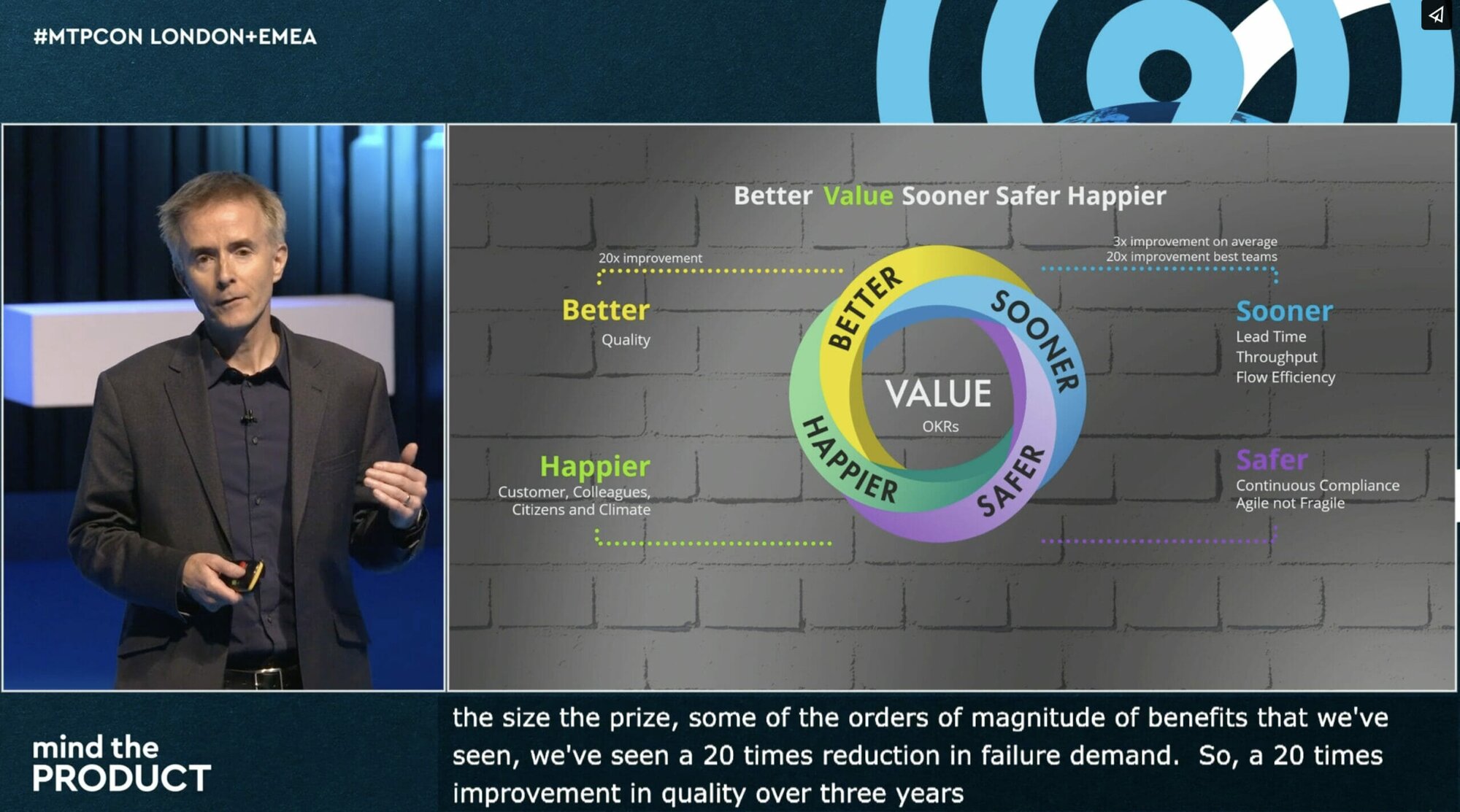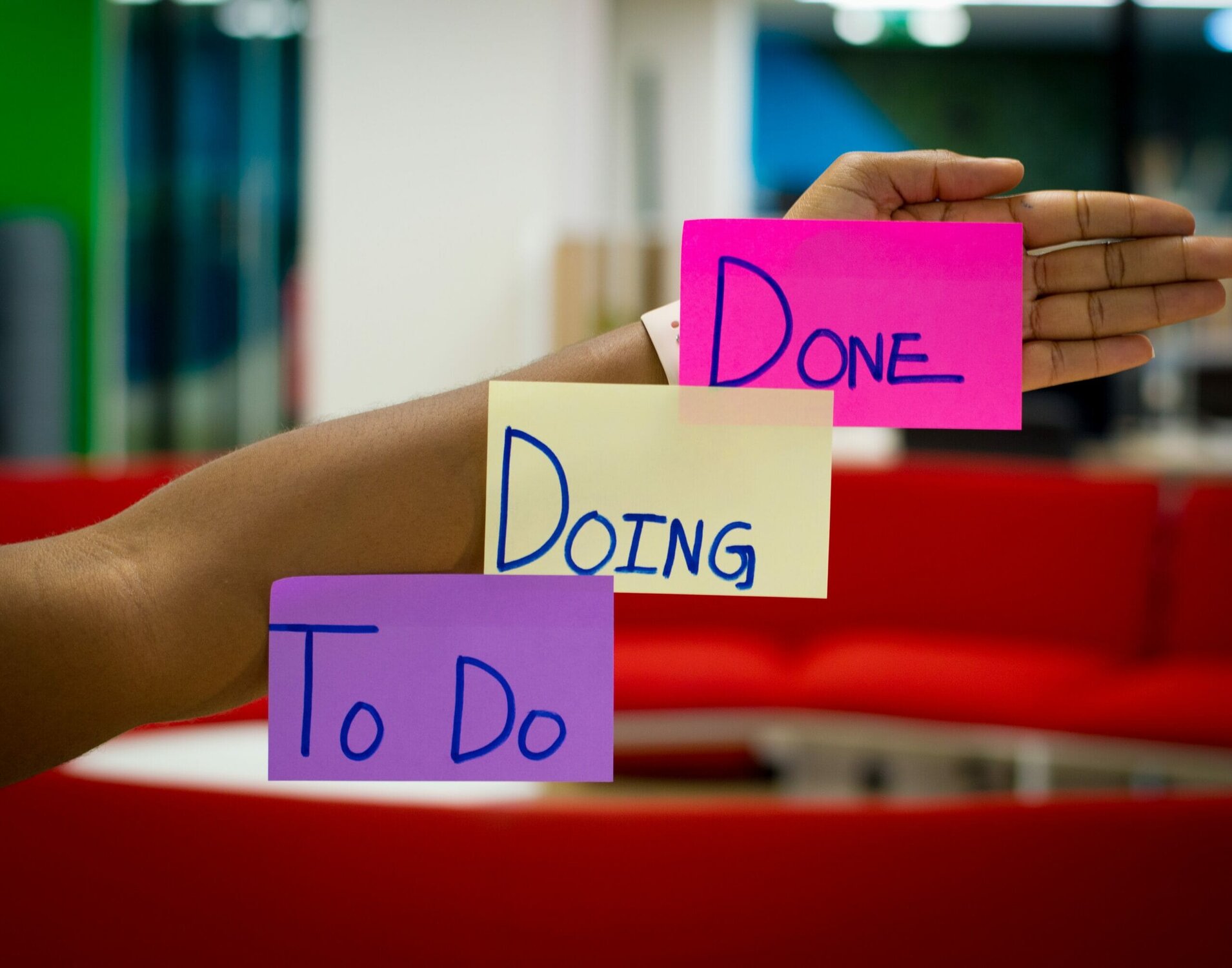In this #mtpcon London+EMEA keynote, Business Agility Coach and Author Jonathan Smart explains how businesses can change their ways of working by adopting agile to deliver better value, sooner, safer, happier, offering lessons in creating an outcome-focussed product culture.
Watch this video or read on for key highlights from the talk.
In brief
- Focus on outcomes over outputs and create a culture of psychological safety that promotes intelligent failure
- Communicate successes, share learnings and promote a community of practice
- Act as a leader and introduce more effective, high-value and healthier ways of working
Lesson 1: Focus on the outcomes
“Who of you has either done, or is doing, or wants to do an Agile transformation?…Don’t”
Agile, John begins, cannot be treated like an “operating system” being installed in a company, with employees expected to “do it — changing the process, but not their behaviours”. An agile transformation is “80% culture and only 20% process and tooling” John says, describing it as being outcome-focussed.
He described 5 balanced outcomes of agile:
- Better: Build quality into the work as opposed to inspecting it later
- Value: Measure and monitor your business's unique value proposition
- Sooner: Minimise the time to learning, gaining insights with every iteration
- Safer: Practice continuous compliance, and make effective planning a priority
- Happier: Improve ways of working to benefit customers, colleagues, citizens and the climate
Lesson 2: Achieve big through small
“Do you want to scale agile?…Don't”
Achieving big through small “requires psychological safety”, John explains, outlining the importance of “descaling the work” in order to scale agility. In a truly agile business, he explains how teams do away with upfront “bloated requirements” and instead look to experiment and learn through iteration, embracing a process which invites “intelligent failure”, leading teams to “succeed sooner”.
As a cultural shift, Jonathan warns against introducing agile as “a big bang” with an initial “peak of excitement or denial” followed by chaos, as this increases the risk of a company reactively returning to old habits. Instead, John says to think big, start small, learn fast, recommending lots of little experiments. "Nail it before you scale it," he says, "you're creating social proof in your organisation.”
Lesson 3: Invite over inflict
Do you want to mandate one way?…Don’t
John explains how, when introducing Agile, you’ll encounter an Innovation Curve of adoption, with a group of innovators followed by first early, and then late adopters, and a group of laggards waiting to pivot at the point of being the odd ones out. What’s important, John says, is to “invite over inflict”, encouraging participation without mandating a “one-size-fits-all approach”.
Introducing the concept of a community of practice, John describes successes he’s found with an open-invite meeting, which gives individuals the option to communicate and champion change. “Focus on the innovators”, John says, describing the importance of building social-proof which can be shared with the wider company to illustrate the benefits and slowly support the cultural change, while encouraging more to follow.
Lesson 4: Go first
Do you want to delegate change?…Don't
“Leadership behaviour will make it or break it” John says, explaining the role you must have as a “servant leader” if supporting this change, one where you can support and remove impediments from teams, while showing the way.
John shares 3 leadership lessons:
- Leaders go first: Act as a role model, embracing best-practice, exhibit courage and vulnerability, while helping nurture those around you.
- Psychological safety: Create a culture that is safe, supportive and allows teams to succeed sooner, understanding the importance of experimentation.
- Adopt an emergent mindset: Acknowledge the future is not knowable, prepare to maintain optionality, being open when learning from and adapting to change.
Lesson 5: Build the right things
Do you want to do water-scrum-fall?…Don't
John explains how agile development means you deliver value early and often, reducing your output, while increasing learning opportunities, stating “it’s about sooner, but it’s not about becoming a feature factory […] building the wrong thing faster, makes you wronger […] it is about time to learning”.
He encourages teams to look at reducing lead time, and measuring value as opposed to velocity or output, explaining it as a “pivot here from productivity to ‘valuetivitiy’”. With the increase in efficiency and reduction in output, teams can “take that time back to speak to the customers to innovate, and to continue to improve your system of work”.
Lesson 6: Minimum viable compliance
Do you want one size fits all controls?…Don’t
When it comes to compliance and controls, John describes how agile businesses often have either too few, leading to instability, or so many it’s like “the brakes are on all of the time”.
He recommends aligning a multidisciplinary safety team to the “flow of value” and introducing process improvements that allow for clearer tracking, structured risk stories, and a culture of collaboration, explaining “the better the brakes, the faster you can go […] have both speed and control”.
“Now all of the work is in one place. We know when it's been done. We know when it's been tested”.
Lesson 7: Pop the learning bubbles
Do you want to have information silos?…Don't.
John describes how information is power, and advises against information silos, instead encouraging us to “pop those learning bubbles and become a learning organisation”.
A community of practice John recommends is introducing ceremonies which recognise and reward knowledge sharing, for example creating team awards, newsletters, meetups, case studies, videos and journals which give teams the ability to share experiences. “I find them to be very powerful — a very powerful way to share learning, agnostic of silos in your company”.
Lesson 8: You’re never done improving
Do you want to create a digital feature factory?…Don't.
John’s parting lesson is to “go slower to go faster". If you don't, he says, "you will end up going slower”. He explains how you require resilience to deliver continuous improvements across an organisation while acknowledging “impediments are the path”, though they shouldn’t come at the cost of incurring technical, process and culture debt. It’s a practice, he says, “this is everybody — not a department of improvement. But this is everybody. And there is no end date.”
Explore more #mtpcon video content






